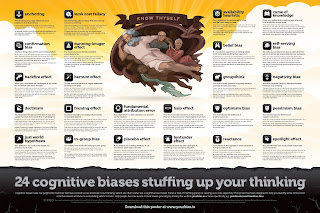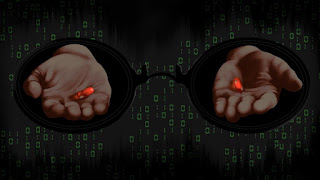Cognitive bias
Cognitive bias is a systematic thought process caused by the tendency of the human brain to simplify information processing through a filter of personal experience and preferences. The filtering process is a coping mechanism that enables the brain to prioritize and process large amounts of information quickly.
TYPES OF COGNITIVE BIASES
The following are just a few types of cognitive biases that have a powerful influence on how you think, how you feel, and how you behave.
1
THE CONFIRMATION BIAS
The confirmation bias is the tendency to listen more often to information that confirms our existing beliefs. Through this bias, people tend to favor information that reinforces the things they already think or believe.
Examples include:
Only paying attention to information that confirms your beliefs about issues such as gun control and global warming
Only following people on social media who share your viewpoints
Choosing news sources that present stories that support your views
Refusing to listen to the opposing side
Not considering all of the facts in a logical and rational manner
There are a few reasons why this happens. One is that only seeking to confirm existing opinions helps limit mental resources we need to use to make decisions. It also helps protect self-esteem by making people feel that their beliefs are accurate.
People on two sides of an issue can listen to the same story and walk away with different interpretations that they feel validates their existing point of view. This is often indicative that the confirmation bias is working to "bias" their opinions.
The problem with this is that it can lead to poor choices, an inability to listen to opposing views, or even contribute to othering people who hold different opinions.
2
THE HINDSIGHT BIAS
The hindsight bias is a common cognitive bias that involves the tendency to see events, even random ones, as more predictable than they are. It's also commonly referred to as the "I knew it all along" phenomenon.
Some examples of the hindsight bias include:
Insisting that you knew who was going to win a football game once the event is over
Believing that you knew all along that one political candidate was going to win an election
Saying that you knew you weren't going to win after losing a coin flip with a friend
Looking back on an exam and thinking that you knew the answers to the questions you missed
Believing you could have predicted which stocks would become profitable
CLASSIC RESEARCH
In one classic psychology experiment, college students were asked to predict whether they thought then-nominee Clarence Thomas would be confirmed to the U.S. Supreme Court.
Prior to the Senate vote, 58% of the students thought Thomas would be confirmed. The students were polled again following Thomas's confirmation, and a whopping 78% of students said they had believed Thomas would be confirmed.1
The hindsight bias occurs for a combination of reasons, including our ability to "misremember" previous predictions, our tendency to view events as inevitable, and our tendency to believe we could have foreseen certain events.
The effect of this bias is that it causes us to overestimate our ability to predict events. This can sometimes lead people to take unwise risks.
3
THE ANCHORING BIAS
The anchoring bias is the tendency to be overly influenced by the first piece of information that we hear. Some examples of how this works:
The first number voiced during a price negotiation typically becomes the anchoring point from which all further negotiations are based.
Hearing a random number can influence estimates on completely unrelated topics.2
Doctors can become susceptible to the anchoring bias when diagnosing patients. The physician’s first impressions of the patient often create an anchoring point that can sometimes incorrectly influence all subsequent diagnostic assessments.3
While the existence of the anchoring bias is well documented, its causes are still not fully understood. Some research suggests that the source of the anchor information may play a role. Other factors such as priming and mood also appear to have an influence.4
Like other cognitive biases, anchoring can have an effect on the decisions you make each day. For instance, it can influence how much you are willing to pay for your home. However, it can sometimes lead to poor choices and make it more difficult for people to consider other factors that might also be important.
4
THE MISINFORMATION EFFECT
The misinformation effect is the tendency for memories to be heavily influenced by things that happened after the actual event itself. A person who witnesses a car accident or crime might believe that their recollection is crystal clear, but researchers have found that memory is surprisingly susceptible to even very subtle influences.
For example:
Research has shown that simply asking questions about an event can change someone's memories of what happened.
Watching television coverage may change how people remember the event.
Hearing other people talk about a memory from their perspective may change your memory of what transpired.
CLASSIC MEMORY RESEARCH
In one classic experiment by memory expert Elizabeth Loftus, people who watched a video of a car crash were then asked one of two slightly different questions: “How fast were the cars going when they hit each other?” or “How fast were the cars going when they smashed into each other?”5
When the witnesses were then questioned a week later whether they had seen any broken glass, those who had been asked the “smashed into” version of the question were more likely to report incorrectly that they had seen broken glass.
There are a few factors that may play a role in this phenomenon. New information may get blended with older memories.6 In other cases, new information may be used to fill in "gaps" in memory.
The effects of misinformation can range from the trivial to much more serious. It might cause you to misremember something you thought happened at work, or it might lead to someone incorrectly identifying the wrong suspect in a criminal case.
5
THE ACTOR-OBSERVER BIAS
The actor-observer bias is the tendency to attribute our actions to external influences and other people's actions to internal ones. The way we perceive others and how we attribute their actions hinges on a variety of variables, but it can be heavily influenced by whether we are the actor or the observer in a situation.
When it comes to our own actions, we are often far too likely to attribute things to external influences. For example:
You might complain that you botched an important meeting because you had jet lag.
You might say you failed an exam because the teacher posed too many trick questions.
When it comes to explaining other people’s actions, however, we are far more likely to attribute their behaviors to internal causes. For example:
A colleague screwed up an important presentation because he’s lazy and incompetent (not because he also had jet lag).
A fellow student bombed a test because they lack diligence and intelligence (and not because they took the same test as you with all those trick questions).
While there are many factors that may play a role, perspective plays a key role. When we are the actors in a situation, we are able to observe our own thoughts and behaviors. When it comes to other people, however, we cannot see what they are thinking. This means we focus on situational forces for ourselves, but guess at the internal characteristics that cause other people's actions.
The problem with this is that it often leads to misunderstandings. Each side of a situation is essentially blaming the other side rather than thinking about all of the variables that might be playing a role.
6
THE FALSE CONSENSUS EFFECT
The false consensus effect is the tendency people have to overestimate how much other people agree with their own beliefs, behaviors, attitudes, and values. For example:
Thinking that other people share your opinion on controversial topics
Overestimating the number of people who are similar to you
Believing that the majority of people share your preferences
Researchers believe that the false consensus effect happens for a variety of reasons. First, the people we spend the most time with, our family and friends, do often tend to share very similar opinions and beliefs. Because of this, we start to think that this way of thinking is the majority opinion even when we are with people who are not among our group of family and friends.
Another key reason this cognitive bias trips us up so easily is that believing that other people are just like us is good for our self-esteem. It allows us to feel "normal" and maintain a positive view of ourselves in relation to other people.
This can lead people not only to incorrectly think that everyone else agrees with them—it can sometimes lead them to overvalue their own opinions. It also means that we sometimes don't consider how other people might feel when making choices.
7
THE HALO EFFECT
The halo effect is the tendency for an initial impression of a person to influence what we think of them overall. Also known as the "physical attractiveness stereotype" or the "what is beautiful is 'good' principle" we are either influenced by or use the halo to influence others almost every day. For example:
Thinking people who are good-looking are also smarter, kinder, and funnier than less attractive people
Believing that products marketed by attractive people are also more valuable
Thinking that a political candidate who is confident must also be intelligent and competent
One factor that may influence the halo effect is our tendency to want to be correct. If our initial impression of someone was positive, we want to look for proof that our assessment was accurate. It also helps people avoid experiencing cognitive dissonance, which involves holding contradictory beliefs.
This cognitive bias can have a powerful impact in the real world. For example, job applicants perceived as attractive and likable are also more likely to be viewed as competent, smart, and qualified for the job.
8
THE SELF-SERVING BIAS
The self-serving bias is a tendency for people tend to give themselves credit for successes but lay the blame for failures on outside causes. When you do well on a project, you probably assume that it’s because you worked hard. But when things turn out badly, you are more likely to blame it on circumstances or bad luck.
Some examples of this:
Attributing good grades to being smart or studying hard
Believing your athletic performance is due to practice and hard work
Thinking you got the job because of your merits
The self-serving bias can be influenced by a variety of factors. Age and sex have been shown to play a part. Older people are more likely to take credit for their successes, while men are more likely to pin their failures on outside forces.7
This bias does serve an important role in protecting self-esteem. However, it can often also lead to faulty attributions such as blaming others for our own shortcomings.
9
THE AVAILABILITY HEURISTIC
The availability heuristic is the tendency to estimate the probability of something happening based on how many examples readily come to mind. Some examples of this:
After seeing several news reports of car thefts in your neighborhood, you might start to believe that such crimes are more common than they are.
You might believe that plane crashes are more common than they really are because you can easily think of several examples.
It is essentially a mental shortcut designed to save us time when we are trying to determine risk. The problem with relying on this way of thinking is that it often leads to poor estimates and bad decisions.
Smokers who have never known someone to die of a smoking-related illness, for example, might underestimate the health risks of smoking. In contrast, if you have two sisters and five neighbors who have had breast cancer, you might believe it is even more common than statistics suggest.
10
THE OPTIMISM BIAS
The optimism bias is a tendency to overestimate the likelihood that good things will happen to us while underestimating the probability that negative events will impact our lives. Essentially, we tend to be too optimistic for our own good.
For example, we may assume that negative events won't affect us such as:
Divorce
Job loss
Illness
Death
The optimism bias has roots in the availability heuristic. Because you can probably think of examples of bad things happening to other people it seems more likely that others will be affected by negative events.
This bias can lead people to take health risks like smoking, eating poorly, or not wearing a seat belt. The bad news is that research has found that this optimism bias is incredibly difficult to reduce.8
There is good news, however. This tendency toward optimism helps create a sense of anticipation for the future, giving people the hope and motivation they need to pursue their goals.
OTHER KINDS OF COGNITIVE BIAS
Many other cognitive biases can distort how we perceive the world. Just a partial list:
Status quo bias reflects a desire to keep things as they are.
Apophenia is the tendency to perceive patterns in random occurrences.
Framing is presenting a situation in a way that gives a certain impression.
A WORD FROM VERYWELL
The cognitive biases above are common, but this is only a sampling of the many biases that can affect your thinking. These biases collectively influence much of our thoughts and ultimately, decision making.
Many of these biases are inevitable. We simply don't have the time to evaluate every thought in every decision for the presence of any bias. Understanding these biases is very helpful in learning how they can lead us to poor decisions in life.
8 Sources
📷
By Kendra Cherry
Kendra Cherry, MS, is an author and educational consultant focused on helping students learn about psychology.



Comments
Post a Comment